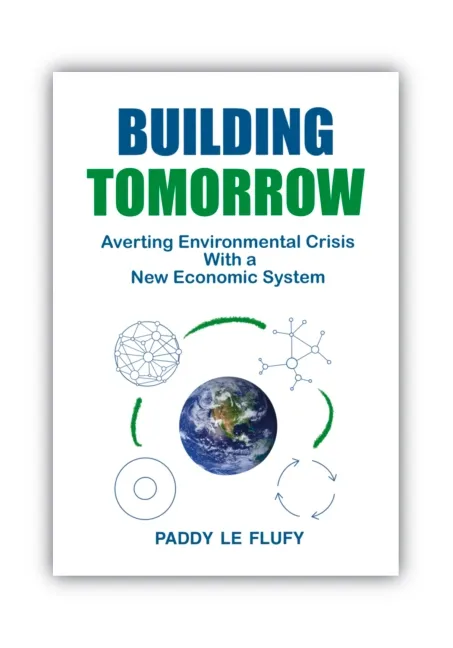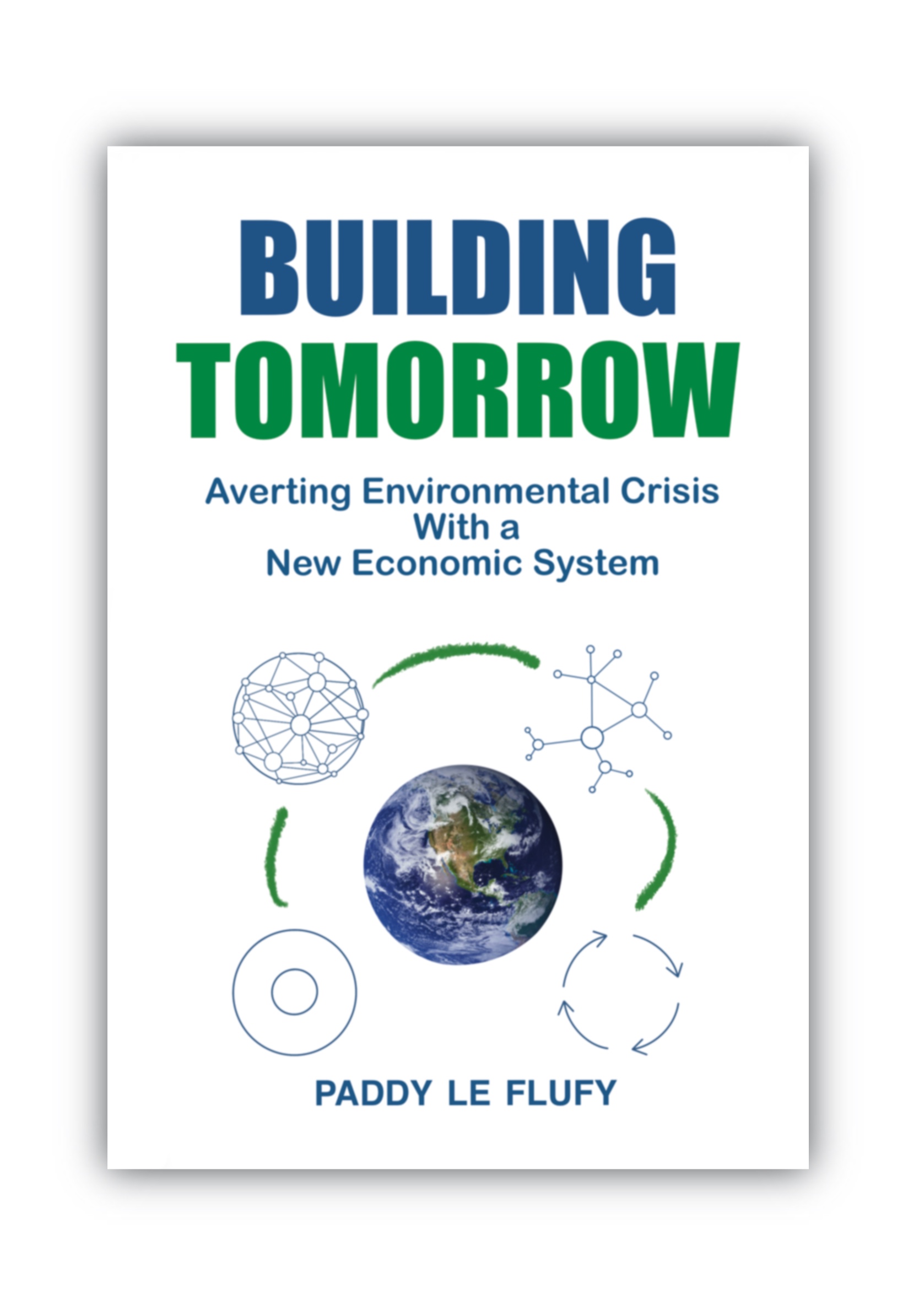
Building Tomorrow
Nadine Storey reviews Paddy Le Flufy's book, 'Building Tomorrow'

Averting Environmental Crisis With a New Economic System
Published by First Light Books, 2023
I think this book deserves a wider audience – but it needs to be clearer on who it is aimed at and marketed accordingly. The cover and title are rather clinical, giving the impression of a book aimed at a specialist audience whereas, in fact, Le Flufy suggests that his target is ‘the average person’ and that his book offers them a menu of ways to make a difference themselves. Kate Raworth’s Doughnut Economics, which Le Flufy draws on for one of his core ideas, is itself a case study in how to market economics to the mainstream: the power of the title and image of that book has led to it becoming a bestseller.
Le Flufy’s book covers six core ideas which are well-known in policy circles but, to varying degrees, would be less familiar to a mainstream audience. To his credit, Le Flufy is not claiming to have invented any of these ideas himself but rather seeks to shine a light on them and explore how they might work in synergy.
- Doughnut Development Paradigm
- Circular Economy
- Future Guardian Governance Model
- Regenerative Organisations
- Sovereign money
- Complementary currencies
Le Flufy is clearly keen to present solutions to offer people a sense of agency, calling this ‘a book of action’. I am not convinced by this. For most people, it would be difficult to act on these ideas. The chapter on sovereign money in particular (based on proposals by Positive Money) seems out of place here. I more readily accept his suggestion that:
The overall vision needs to be more widely known and understood. People need to support the organisations working to support the new system.
Increased awareness and understanding seem to be more realistic goals and it might have been better to position the book this way throughout.
Le Flufy presents the ideas in the book as ‘technologies’ which is reminiscent of Ivan Illich’s Tools for Conviviality. The two writers share the aim of reclaiming the word, bringing it down to earth. Illich, however, was writing in 1973 when the global population was less than half that of today and when annual carbon emissions were at considerably less than half (Our World in Data). The ideas that Le Flufy puts forward are all needed but the upbeat tone of the book, implying that this is all we need to do, risks breeding complacency. As Dr Gary Kendall has calculated, if we had taken decisive action even twenty years ago, we could have worked to a 1-2% annual emissions reduction target with a carbon budget to last until 2100. Twenty years on, we have burnt through fifty years of that budget and need at least a 7-8% annual reduction. The level of urgency we are now facing suggest the need for decisive action by governments, enforced through legal mechanisms, rather than relying on voluntary change of the type Le Flufy is proposing.
This book proposes six technologies with very little critique. As a book for a mainstream audience, it may make sense to avoid complex arguments. However, it would be interesting to see Le Flufy engage critically with the realities of operationalising these ideas, just a few of which are touched upon below.
The Doughnut Development Paradigm
Kate Raworth’s original Oxfam paper describing the doughnut concept is now 11 years old. Her book, ‘Doughnut Economics’, was published 6 years ago and has since been translated into 20 languages. It is clear that people are attracted to the doughnut concept and it is often offered up as a solution. Le Flufy correctly refers to it as a framework rather than a solution in its own right and recognises that it is ‘a fundamentally global concept’. However, he is happy to cite examples of downscaling the doughnut. This is potentially problematic because it seems that few people appreciate the extent of levelling down (rather than up) in terms of material resources and energy that is needed in developed nations to get inside the doughnut - as calculated for example by Millward-Hopkins et al. in their 2020 paper. When a city or region considers its social foundation, do they start from where they are or take as their starting point the radical reductions needed to share energy on an equitable global basis? Currently this challenge seems to be hiding in academic circles but will eventually need to be shared and discussed more widely.
Circular Economy
Like Doughnut Economics, the circular economy is a well-established concept but one that is all too often co-opted and used for greenwashing. Le Flufy falls into the trap of emphasising the recycling aspect of the circular economy rather than the need for a reduction in material use overall which should be the priority. He acknowledges limitations, for example with the statement, ‘There will probably always be leakage of some kind’. As a reader, it feels dissatisfying to receive no further exploration of the issue. The Teemill example certainly looks to have merit but the claim of infinite recycling of cotton t-shirts sounds implausible. I wonder whether a more investigative approach that questions the claims made by the case studies is called for here. A more straightforward idea is proposed in the ‘tool library’ which is also a more achievable project for the average reader.
Future Guardian Model
Le Flufy offers an interesting idea for business governance.[1] However, he is keen to avoid proposing legal reform which looks increasingly certain to be required to drive sufficient – and sufficiently rapid – societal change. His example, Riversimple, has adopted a rather complex stakeholder model which yet regards shareholders as equal to the environment. Faith In Nature’s model of Nature on the Board is a simpler and more powerful concept and likely to be followed by more companies.
Both these ideas are a good start under current legal restrictions which favour shareholders. However, given the urgency of the crisis, we can’t rely on voluntary moves by civic minded business owners. Perhaps the public could be asked to get behind a radical change to the Companies Act which puts planet and people ahead of profit? If we see profit-seeking as equivalent to the health of Planet Earth, we enter the dubious field of seeking to put a price on nature and trade it off against short-term financial interests. As fellow Green House member, John Foster, has written, this is a fundamental error because a healthy planet is an ‘absolute precondition’ of life.
Regenerative Organisations
This section of the book gives a flavour of the type of activity that is taking place at grass-roots level, perhaps out of sight of the majority of the population, and thus works well to educate and inspire. For further inspiration along these lines, readers might like to dip into The Commoner’s Catalog for Changemaking or The Open Book of Social Innovation.
Inviting people to get involved in this type of enterprise is laudable. However, we have reached the stage of the game where it is disingenuous to suggest that individual action by a growing minority will be sufficient. We need all levels of society to act in concert and we need, critically, an overhaul of governance systems and structures.
Sovereign Money
As mentioned previously, I don’t think this topic quite belongs in a book intended to be a guide to practical action for ordinary members of society. It is a highly debated and contested area amongst experts. For a deep dive on this, Green House has an article forthcoming. For an ordinary member of society, perhaps a better goal is simply to build understanding of how the monetary system currently works and to be made aware that change here would be only one way in which the whole economic system needs to change.
Complementary Currencies
Others may have different views but I believe that complementary currencies are something of a distraction, at least in a UK context. From my understanding of the trials of complementary currencies in the UK, their main achievement has been, not to change the monetary system to any real degree, but to grant a legacy of increased community cohesion. This has been at a significant cost in terms of time and effort that could be spent in a different way if such cohesion is the primary aim.
In summary, I can certainly see some value in enabling the ideas Le Flufy has outlined to reach a wider audience. However, I think they need to be presented in a different way to achieve that goal and to ensure that readers are not left oblivious to the significant upheaval that is needed in society and the urgency of change.
Le Flufy indicates the potential for a synergistic effect by combining these concepts. I have no doubt that potential is there but would be even stronger – and more clearly up to the urgent task ahead – if combined with firm commitments and leadership at governmental level.

[1] A Green House publication by Rupert Read makes the case for future guardians in a different context – that of participative democracy.


